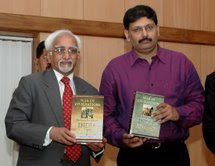Indian Express review 24th February 2008

150 Years Later
by Bibek Debroy
This is a book of great courage and perseverance. Authoring a two-volume magnum opus of more than 2,000 pages, on any subject, is not easy. Amaresh Misra’s earlier books on Lucknow and Mangal Pandey establish his interest in events centred on 1857. The first volume is better written than the second.
However, this is more than compensated by extensive research. There is also an interesting experiment in the first two chapters of the first volume (concerning Azimullah Khan and Azeezun Bai) of using the fiction genre to describe events. This works quite well, except that the reader can’t always distinguish fact from fiction. But this isn’t an experiment that is repeated subsequently. The Misra propositions can be segregated into a few strands. Some have been established fairly convincingly, others less so.
First, the Mughal state came close to “establishing a mercantile industrial capitalism”, with the pressure for change emerging from a small town and rural economy that clashed against town capitalism led by big merchants and protected by the bureaucracy. This was a clash between two forms of capitalism. The argument thus turns the conventional approach, influenced by the West, on its head. Novelty is no argument against rejecting a hypothesis. Suffice to say that Misra has marshalled enough evidence to build his case. While the proposition isn’t quite proven, it merits serious consideration.
Second, Mughal India didn’t exhibit rigidities of caste and religion. A composite and secular social structure had emerged. It was the British who created communalism.
Third, 1857 wasn’t a simple sepoy mutiny or a civil rebellion. It was much more broad-based than that and lasted well beyond 1857, all the way into the 20th century. It was a war of civilisations. “The conventional view that Indians lost militarily or politically has to be overhauled… Despite everything, Indians could still have won a conventional victory — it was only internal betrayal that probably skewed this possibility.”
Fourth, the number of Indians killed has been under-estimated. Computed afresh, figures represent almost a mass genocide. The Misra estimates are 10 million killed (7 per cent of the population) in UP, Haryana and Bihar alone. Fifth, several post-1947 developments in India and Pakistan can be traced to 1857. Sixth, outside the subcontinent, the 1857 struggle resonates in the Middle East, Africa and Latin America too.
Misra’s political ideology comes across in these propositions. There is nothing wrong with that, unless it leads to subjective biases. “It was the 1857 fear that forced British and Indian liberals, like Dadbhai (sic) Naoroji, to establish the Congress as a safety valve, capable of deflecting Indian revolutionary energies... It is clear that the British left India for they feared another 1857; the reformist leadership of both the Muslim League and the Congress also feared such a prospect — around 1947, a new 1857, would have meant a new, Hindu-Muslim unity — there would have been no Partition.”
Personally, I find that the first four propositions have been far better established than the last two, though the figures can still be accused of being somewhat back-of-the-envelope. However, there is yet another proposition that transcends all these and this is of 1857 being under-researched, with clichéd perspectives taken for granted. “Despite the instance of the chapters bringing forth hitherto unpublished material and a new look at the available, published, primary and secondary sources, 1857 research is still on a preliminary level; at the end, there are more questions than answers.” Against this background, this monumental work can be described as near-seminal.


Comments